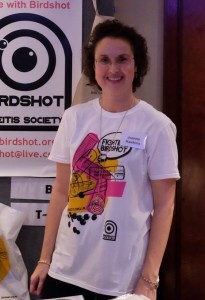Research Study: Genetic polymorphism and outcome in uveoretinitis syndromes (also known for short as GPOUS Study)
This is just a heads up that over the next few months, people with Birdshot Uveitis attending Moorfields and other eye clinics may be asked if they would like to take part in the above study. The aim is to get another 100 people with Birdshot from the Moorfields cohort to join in. On the particular day in June when I was asked, there was at least one other Birdshotter that I know who also took part.
The researchers are looking at a number of different eye conditions, but if they have a largish cohort of Birdshot Uveitis patients, they may well get some useful pointers as to why some cases of Birdshot are more severe than others, and why some are easier to treat. The information may well be useful in helping to determine less toxic treatment strategies.
There are a number of other participating eye hospital sites, including St Thomas’ (London), Birmingham, Bristol, Brighton and Manchester.
It is encouraging that we are managing to utilize the National Birdshot Research Network to get the various different hospitals to work together so that there are sufficient patients that can be studied in a meaningful way.
After I had donated my ’two tablespoonfuls’ of blood, I subsequently had the opportunity to quiz Professor Miles Stanford. I asked him if it would be possible for the information about Birdshotters’ DNA and blood samples to be fed into the Birdshot Database.
The answer, unfortunately, was no, but he indicated that ethical approval had been granted so that the anonymised DNA samples could be retained and used by other researchers to look at other genetic risk factors.
Here is some background information taken from the patient information sheet that the researchers gave me to read, so if a researcher approaches you when you are in the eye clinic and asks you if you are interested in participating, you have a little more information in advance.
Background and Purpose:
Uveoretinitis syndromes are a group of diseases that affect the eye and cause inflammation within it. In approximately half of the cases, the inflammation appears to be confined to the eye, and in the other half it appears in association with inflammation elsewhere in the body, commonly arthritis. It is not a very common disease and if the inflammation gets severe it may threaten vision permanently. In these cases it is necessary to treat patients with drugs which, whilst usually effective, often have unpleasant side effects or require regular hospital visits for monitoring.
We do not know why patients develop these diseases or what causes one patient to have a mild form and another to have a more severe form. Our research over the last ten years has suggested that the outlook for vision is determined in part by the genetic make up of the patient, particularly in a group of genes that control the production of molecules that either make the inflammation worse or others that make it better. It is now possible to target these molecules with specific drugs, so the ability to know whether an individual’s disease is driven by an excess of molecules that cause inflammation or by a lack of molecules that make it better is becoming very relevant for treatment.
The aim of the current research study is to relate the different genes that a patient has to the outcome of their disease at 5 and 10 years. By using various combinations of the genes we hope to produce a test that can predict the outcome of the disease in 5 and 10 years time. If we can do this then we will be able to reassure patients with a good outlook and devise more appropriate treatments for those where the outlook is less good.
What will happen to me if I take part?
If you do decide to take part, your examination is exactly the same as would happen when you are seen in the eye clinic. After your routine eye examination, we will then ask you to sign a consent form to show you have agreed to take part and we will then take a small blood sample (2 tablespoonfuls) from you for our research study. These samples will then be available to researchers who are investigating the genes and markers that may influence the sort of eye disease that you have and its severity. We will also require your medical history from your GP or hospital records and we will continue to monitor your disease’s progress over 10 years. We will let your GP know that you have agreed to take part in the study
What are the side-effects and possible disadvantages of taking part?
If you take part in the study you will spend longer in the clinic than if you do not, as the doctors will be spending time explaining the study to you and taking the blood sample. There are no other disadvantages to taking part in the study.
What will happen to the blood sample?
The blood sample will be processed in the laboratory to extract the genetic material (DNA) from the cells. This DNA can then by analysed to look for genes that we think may have an effect on the risk of developing uveoretinitis. Your sample will then be frozen in a locked freezer in a secure laboratory.
What will happen to the results of the study?
Any results that emerge from the study will be published in scientific and medical journals. The results from the study will be anonymous and the identity of individuals taking part will not be declared. It will not be possible for you to learn of the results of tests on your blood sample in this study.
Who is funding the research?
The research is being funded by a grant from the Guide Dogs for the Blind Association and the research will be carried out jointly between St Thomas’ Hospital and the University of Birmingham. Future studies on the blood samples from this collection will be undertaken by various other groups and funded separately. The future use of your sample in other studies will only be allowed if ethical approval for individual projects had been obtained first.
How long will the research last?
The aim is to record how your eye disease progresses over a 5 year period to determine the eventual outcome. We already know from previous studies that the vision at this time predicts the outcome at 10 and, in some cases, 15 years. It is intended that the large number of blood samples generated from this collection will be available for many years afterwards to doctors and scientists as more genes that might cause or influence the severity of uveoretinitis are discovered. However, the identity of the people providing the blood samples would remain unknown to them.

